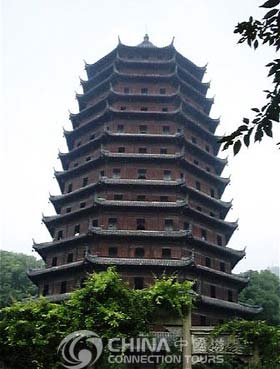
 The Six Harmonies Pagoda, also known as the Liuhe Pagoda, sits on the southwestern fringe of Hangzhou. It is a perfect symbol of brick-and-wood structure built in the ancient China. It is first built in 970 AD in the Northern Song dynasty (960-1127) by Qian Hongchu, the king of Wuyue, who ruled the area of today's Jiangsu, Zhejiang and Fujian provinces. The purpose of building the pagoda was to press down the evil of the river tidal bore in Qiantang River. There is a myth about the construction of the pagoda. Qiantang River often suffers from tidal bores that surge up from Hangzhou Bay. The Dragon King controlled these. Hearing of this, a boy named Liuhe summoned up magical powers to stop the Dragon King's actions. Hence, the local farmers built this fine wood and brick structure in his name. The name "six harmonies" comes from the six Buddhist ordinances, meaning "harmonies of the heaven, earth, east, west, south and north".
The Six Harmonies Pagoda, also known as the Liuhe Pagoda, sits on the southwestern fringe of Hangzhou. It is a perfect symbol of brick-and-wood structure built in the ancient China. It is first built in 970 AD in the Northern Song dynasty (960-1127) by Qian Hongchu, the king of Wuyue, who ruled the area of today's Jiangsu, Zhejiang and Fujian provinces. The purpose of building the pagoda was to press down the evil of the river tidal bore in Qiantang River. There is a myth about the construction of the pagoda. Qiantang River often suffers from tidal bores that surge up from Hangzhou Bay. The Dragon King controlled these. Hearing of this, a boy named Liuhe summoned up magical powers to stop the Dragon King's actions. Hence, the local farmers built this fine wood and brick structure in his name. The name "six harmonies" comes from the six Buddhist ordinances, meaning "harmonies of the heaven, earth, east, west, south and north".
The pagoda has fallen into ruins and gone through reconstruction many times. The original pagoda is nine storied with a light on the tip, serving as a navigation tower in the river. The present tower was the restoration in 1156. Seen from outside, the tower, with a height of 59.89 meters, have 13 stories while in fact only seven stories inside. It is one of the tallest pagodas in southern China. The core of the present pagoda was built with the bricks left over from the Southern Song dynasty. The upturned wooden multi-eaves and wrapping structure were first built in the ending years of the Qing dynasty and have been refurbished many times. Inside the pagoda winding staircases line the walls, leading to the top level. Each storey has a square room, its ceiling supported by brackets. The sunken panel on the ceiling was made by stacking bricks to form saw edges. The walls of the pagoda are carved with human figures, flowers, birds, fish, insects and other decorative patterns, all vividly done. The balconies with banisters around each storey are spacious and convenient for people to walk around and enjoy the beautiful landscape in the open.
Commanding a spectacular view of the surging Qiantang River, the pagoda presents a quiet image of age-old majesty. Ascending to the top of the pagoda and looking down, one has a panoramic view of the beauty of the Qiantang River, feeling as if "standing above the highest level of the sky".
Over the years the Liuhe Pagoda serves as both lighthouse and temple. Its summit is a favorite place to watch the tidal bores that still tear up Qiantang today. The Six Harmonies Pagoda has been under the state protection since 1961 as a state-level cultural site.

